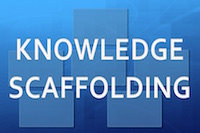Knowledge scaffolding visualizations: A guiding framework
 In this paper we provide a guiding framework for understanding and selecting visual representations in the knowledge management (KM) practice. We build on an interdisciplinary analogy between two connotations of the notion of “scaffolding”: physical scaffolding from an architectural-engineering perspective and scaffolding of the “everyday knowing in practice” from a KM perspective. We classify visual structures for knowledge communication in teams into four types of scaffolds: grounded (corresponding e.g., to perspectives diagrams or dynamic facilitation diagrams), suspended (e.g., negotiation sketches, argument maps), panel (e.g., roadmaps or timelines) and reinforcing (e.g., concept diagrams). The article concludes with a set of recommendations in the form of questions to ask whenever practitioners are choosing visualizations for specific KM needs. Our recommendations aim at providing a framework at a broad-brush level to aid choosing a suitable visualization template depending on the type of KM endeavour.
In this paper we provide a guiding framework for understanding and selecting visual representations in the knowledge management (KM) practice. We build on an interdisciplinary analogy between two connotations of the notion of “scaffolding”: physical scaffolding from an architectural-engineering perspective and scaffolding of the “everyday knowing in practice” from a KM perspective. We classify visual structures for knowledge communication in teams into four types of scaffolds: grounded (corresponding e.g., to perspectives diagrams or dynamic facilitation diagrams), suspended (e.g., negotiation sketches, argument maps), panel (e.g., roadmaps or timelines) and reinforcing (e.g., concept diagrams). The article concludes with a set of recommendations in the form of questions to ask whenever practitioners are choosing visualizations for specific KM needs. Our recommendations aim at providing a framework at a broad-brush level to aid choosing a suitable visualization template depending on the type of KM endeavour.







